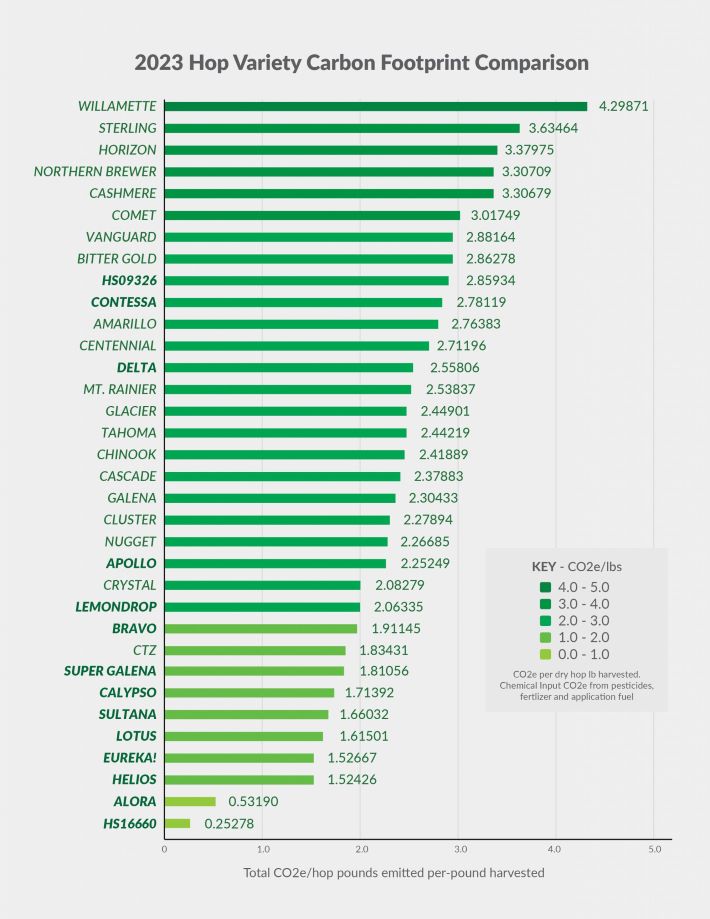
Hopsteiner has updated a list of the CO2 equivalent emissions (CO2e) of 34 hop cultivars it grows on its farms. Greenhouse gas emissions are associated with the formulation, packaging, and application of multiple inputs, such as such as water, fertilizer, pesticides, and fuel. Hopsteiner measured these inputs by compiling hop production records, cone yields, and alpha-acid yields across multiple varieties to determine the carbon footprint associated with each variety.
This list tracks Hopsteiner proprietary (in bold) as well as public varieties, but not every public variety and not many other proprietary varieties. Those include four of the most grown American varieties — Citra, Mosaic, Simcoe, and HBC 682.
Comparing the new list to one from 2021 illustrates that emissions are crop year dependent. This is agriculture.
Doug Wilson, Hopsteiner director of sales and marketing, cautions that data for Alora and HS16660 is based on limited data. Alora was still an experimental variety last year, so acreage is limited. HS16660 is still experimental, grown in a five-acre yard. Both, however, were selected for disease resistance and yield — two important qualities to lower (CO2e).

Related: Some hops are ready for climate change; some are not.
According to the Greenhouse gas emission calculator from the Bavarian Institute for agriculture Mittelfrüher has a footprint of 5,6 tons CO2/ha ( 4,15 Kg CO2 / Kg Hops) and on the opposite side Herkules has 8,1 tons CO2 per ha and due to the much higher yields the average result is of 2,87 Kg CO2 / Kg hops is lower. Drying alone makes 1,3 to 1,5 Kg CO2 per Kg hops. These Hopsteiner published figures without disclosing how they come to be are confusing and misleading, because unless Hopsteiner has invented a variety that comes already dry from the bine, these numbers, even with a 5 ! Decimal precission, cannot be used to compare the CO2 footprint of hops across borders.
Hi Carlos – Hopsteiner has shared such information in making presentations at conferences, etc. The story I wrote for The New Brewer includes some of that, plus efforts of Hop Growers of America to quantify this, certainly including the impact of kilning. Which as you point out is gigantic, and variable.
Hopsteiner makes it clear these numbers are for hops grown on its farms. For instance, given the horrible yield of Centennial on same farms in the NW this year the carbon footprint in those fields was much was than portrayed on the chart.
This is only the beginning of what I hope is a large conversation. It would be great to come up with a standard that compares the footprint of Saaz, Hersbrucker, Motueka, Galaxy, Citra, Diamant, Strata, etc. — with variations depending on they are grown.
Yes Stan, sustainability and CO2 reduction are the topic of the day and it would be great, if we had an industry-wide accepted method of accounting, so that we don’t compare apples and pears. Maybe I’m just missing a piece of Info here, but then this also applies to the rest of the readers of these figures.
I agree, Carlos, an industry-wide method would be great.